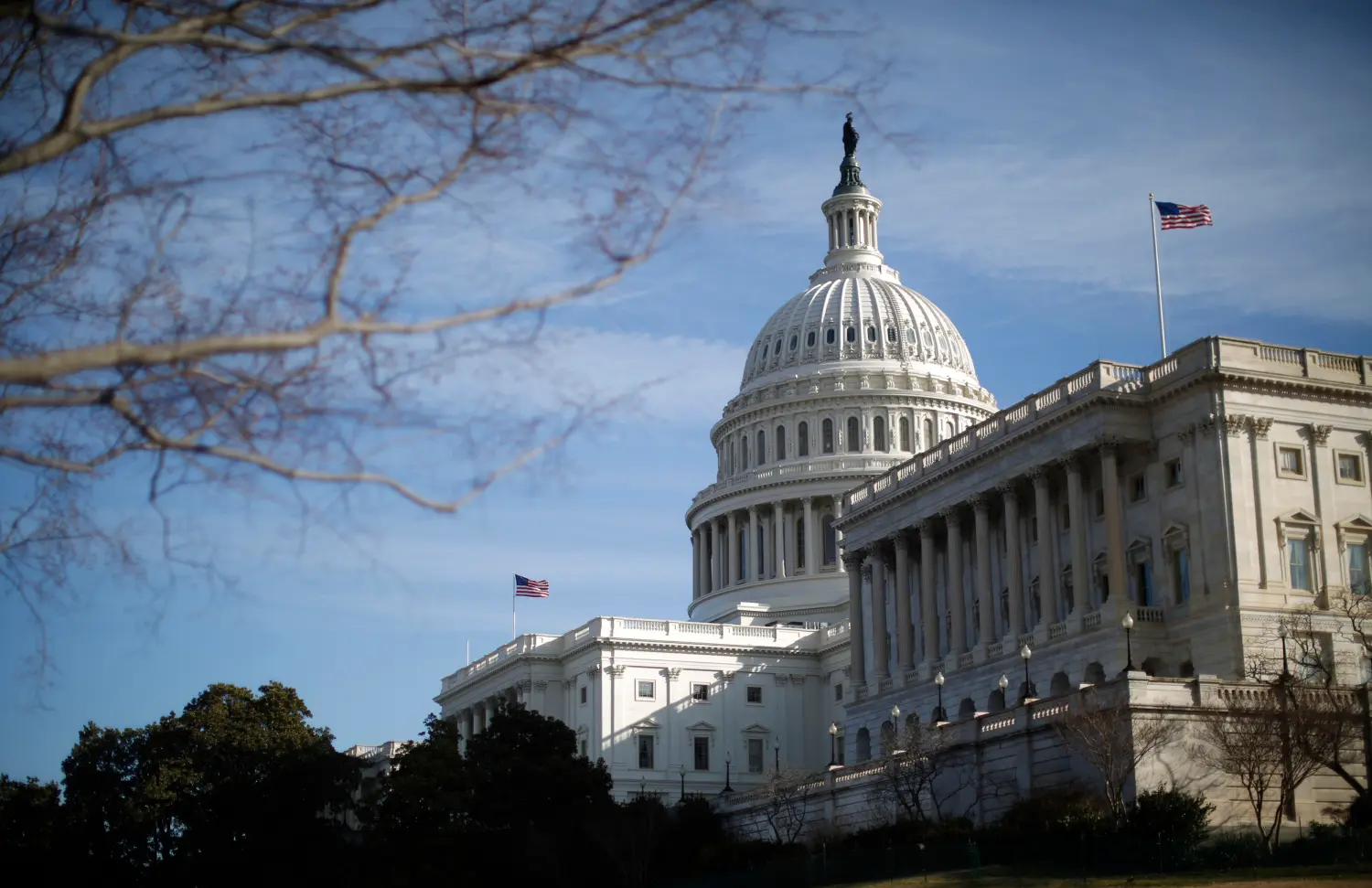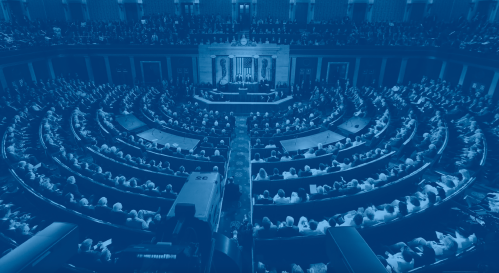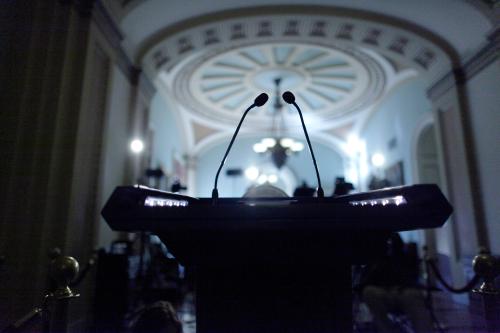Congressional oversight has been in the headlines for much of 2019 and is likely to remain a focus of legislative attention for the foreseeable future. The experience of the House of Representatives over the past year, however, has revealed a number of persistent issues that plague the first branch as it attempts to assert its authority over the executive branch. I argue we need not only changes to the oversight process, but broad congressional reforms that improve the institution’s capacity to address problems, enact legislation, and bolster legislative influence.
The problem of congressional oversight
Congress’s challenges in exerting itself as a meaningful check on the executive branch take several forms. One involves the legislative branch’s capacity to gather and process information about what is happening in federal agencies and the White House—a task that requires sufficient staff resources. In the absence of internal capacity to undertake these tasks, Congress is forced to either turn to outside sources—like lobbyists—to get the information members need or leave oversight undone.
Evidence from research on Congress suggests that in individual House member offices, the presence of highly-experienced staffers makes for more effective lawmakers.1 This research does not find a relationship between the number of legislative staff in House personal offices and legislative effectiveness, but if there are negative effects of staff levels on the functioning of congressional committees, then the House is ripe for them. For example, Republicans assumed majorities in both chambers for the first time in 40 years in 1995 after promising to eliminate one-third of committee staff as part of the broader promise to reduce the size and scope of the federal government included in the Contract for America platform on which Republicans had contested the 1994 elections. House committee staff levels have periodically grown since the large reductions in the mid-1990s, but they remain lower than their pre-1995 levels.2 (The new Republican majority also eliminated the Office of Technology Assessment, an agency designed to provide Congress with analysis of complex scientific and technological issues.)
In addition, the challenge of ensuring that members have access to the kind of experienced staff who can gather and process information effectively is made more difficult by current policies surrounding staff pay. The maximum amount that staff members can be paid is capped.3 Most individual member offices do not have large enough budgets to consider paying staff members at the maximum level, but the salary cap does affect the ability of committees, especially those with demands for sophisticated expertise, to attract and retain talent.
In light of these trends, research suggests that Congress’s approach to processing information in committees has, in fact, changed. While it is not clear how much of that evolution is the result of the capacity shifts outlined above, we have seen Congress receive more one-sided information in committee hearings than in the past and spend less time in those sessions learning about possible solutions to policy problems.4
The idea that oversight is affected by partisanship is by no means new. Political science research that examines congressional investigations of the executive branch between 1898 and 2014, for example, finds that scrutiny is higher when different parties control the two branches.5 But, in recent years, Congress’s efforts to conduct oversight of the executive branch, especially on high-profile matters, have become increasingly reliant on using the federal courts to enforce the legislature’s demands for information and testimony. Congress’s ability to subpoena documents and testimony, and to hold individuals in contempt if they do not comply have long been important tools that the House and Senate have used as leverage against the executive branch. But historically, they have served more often as actions to be threatened than as ones to actually be executed. As former Representative Tom Davis (R-Va.), who chaired the House Committee on Oversight and Government Reform from 2003 to 2007, put it recently, “traditionally, this stuff gets negotiated. You ask for the moon and you end up with a moon rock.”6
In several recent episodes involving the executive branch—both prior to, but especially during, the Trump administration—this process of negotiation and accommodation has failed and the federal courts have been become implicated in congressional oversight at key moments. In 2008, the House of Representatives held former White House Counsel Harriet Miers and White House Chief of Staff Joshua Bolten in contempt for refusing to comply with subpoenas related to the resignations of nine U.S. attorneys and forwarded the contempt citations to the U.S. attorney for the District of Columbia for further action. Under a longstanding Department of Justice policy, however, DOJ refused to prosecute Miers and Bolten because they were invoking executive privilege at the direction of the president. In response, the House filed a civil suit seeking to enforce the subpoenas. In 2012, the House took similar action against Attorney General Eric Holder over non-compliance with a subpoena regarding “gun walking” as part of an operation by the Bureau of Alcohol, Tobacco, and Firearms known as “Fast and Furious.”7 In the current Congress, non-cooperation with congressional subpoenas has led, among other actions, to a lawsuit against former White House Counsel Don McGahn, as well as against several private firms who hold financial records from the Trump Organization. In addition, the House is also pursuing legal action against the Internal Revenue Service for non-compliance with a separate statutory requirement to disclose President Trump’s tax returns.8
From Congress’s perspective, using the federal courts to enforce compliance with congressional subpoenas presents a major operational problem: the process is extremely slow. (There are also questions raised about this approach from those who favor a more aggressive assertion of Congress’s inherent contempt power and from those who believe it may create separation-of-powers concerns.9
The Miers case was not ultimately settled until March 2009, after a new Congress and new presidential administration; the “Fast and Furious” case similarly persisted into the next presidential administration without being fully resolved.10 Similar protracted schedules are confronting the current House’s oversight efforts. Even cases being heard on expedited schedules are slow-moving in relation to political time; the case involving the accounting firm Mazars USA, LLP, for example, began in April 2019 and remains unresolved at the time of this writing.11
The oversight process is not the only arena in which the contemporary Congress must contend with the fact that tools that were once central in its institutional toolbox have been rendered less effective in asserting power against the executive branch. For example, the increasing use of single, large spending bills—either on a temporary or long-term basis—has changed the dynamics of Congress’s ability to use the appropriations process to exert its will against the president. When derailing a single piece of legislation has the potential to shut down large parts of the federal government, Congress may be less willing to go to the mat for specific restrictions on executive branch actions. Indeed, observers and participants were somewhat surprised when President Trump pursued such a strategy in December 2018, when his “sudden refusal to sign anything without wall funding … [threw] Congress into a tailspin with just hours to go until a shutdown.”12
We see a similar challenge in Congress’s efforts to use special procedures it previously created that are meant to enhance its ability to review actions of the executive branch. Recognizing certain imbalances of power between it and the executive branch and that, in many areas, the president has an informational advantage over Congress, the legislative branch has periodically devised specific procedures for considering resolutions that would either overturn an action taken by the president or delay it from taking effect until Congress approves.13 Several of these procedures have risen to prominence during the Trump administration. At the beginning of his presidency, for example, congressional Republicans made significant use of the Congressional Review Act, which allows Congress to overturn regulations promulgated by the executive branch in a certain, relatively narrow window after they are finalized. More recently, Congress has passed resolutions aimed at blocking arms sales to Saudi Arabia and the United Arab Emirates and disapproving of President Trump’s decision to declare a national emergency concerning the southern border of the United States.14
Importantly, these procedures usually provide for expedited consideration of the relevant piece of legislation—including protecting it from the possibility of a filibuster in the Senate. In principle, then, these procedures should make it easier for Congress to push back against the executive branch than using the regular legislative process. But thanks to the 1983 Supreme Court ruling in Immigration and Naturalization Service v. Chadha, these measures overturning actions by the president must go to his desk for a signature or veto; Congress cannot reverse them simply by adopting an internal resolution.15 As a result, even when Congress has special procedures at its disposal that should make it easier to act, it still must either have the assent of the president or enough support in the House and Senate to override his veto. Unsurprisingly, the president is often unwilling to sign measures that explicitly reject an action he has just taken. Indeed, all six vetoes issued by President Trump as of this writing have been on resolutions that would have overturned decisions he made or otherwise limit his power.16 Given that is also difficult—thanks to high levels of partisanship and polarization—to build the supermajority coalitions in the House and Senate needed to override a veto, the ability of Congress to use the procedures it developed to enhance its institutional capacity has been significantly weakened.
How did we get here?
The fact that its old tools don’t work the way they once did, however, is only part of the story behind why Congress has been weakened as a branch. Indeed, the decline of congressional capacity, the weakening of oversight powers, the decreased utility of the power of the purse, and the difficulty in adopting legislation to overturn executive branch actions are all symptoms of broader changes, both in Congress and in the political system at large.17
Since the early 1980s, polarization in Congress has increased, largely due to the movement of Republican members to the right over time.18 To be sure, when legislating still happens in Congress, it largely does so on a bipartisan basis.19 But it is also true that gridlock—or the share of issues that Congress could be addressing but does not—has grown over time.20 This kind of polarization does not lend itself to legislative cooperation and working collaboratively, including on issues that would push back against executive branch power.
Increasing partisanship has also made it more difficult for members of Congress to assert its authority as the first branch. The electoral fate of individual legislators is now more closely tied to national political forces than in previous eras. Voters split their tickets at much lower rates; in 2016, for example, no state elected a senator from one party while awarding its Electoral College votes to a presidential candidate of a different party for the first time since the advent of popular election of senators in the early 20th century.21 These electoral circumstances reduce the incentive of many legislators to work across the aisle to build independent brands that might include pushing back against an executive branch helmed by a president of their own party.
The increased competition for partisan control of the House and Senate has also made working with members from the opposite party less attractive. Between the early 1950s and the early 1980s, Democrats held a virtual lock on the congressional majority, and Republicans did not reasonably expect to regain the majority after each successive election. Since roughly 1980, however, both parties have seen achieving a majority in the next cycle as an at least somewhat achievable goal. Because of this heightened competition, members of the minority party have fewer reasons to work with their majority party counterparts to make them seem like capable legislators. Instead, they have a greater incentive to draw clear distinctions between their own party and their majority party colleagues.22
Furthermore, as the president has become an increasingly polarizing figure in American politics, issues that might have once been seen as questions of institutional power and pride are more likely to be seen in partisan terms as “for” or “against” a president of one’s party.23 Even when an issue might otherwise be fertile ground for cross-partisan coalition-building, it can be harder to do so if it is too closely identified with the president. In 2015, for example, when President Obama was seeking new authorization from Congress to negotiate trade deals, Republican congressional aides asked the White House to stop asking that Congress “give” him the power, lest they be seen as “giving” a Democratic president special powers.24
This reluctance to be seen as granting power to an opposite party president co-exists with several decades of increasing presidential power. Some of this expansion is of Congress’s own making, as legislators seek to take advantage of certain types of expertise in the executive branch and to shift responsibility for potentially controversial or politically charged policy choices to a different branch of government. Once Congress has delegated this authority to the executive branch, however, the president has used various tools to expand his power further. Polarization and partisanship in Congress, in turn, have made it difficult for Congress to wrest much of this authority back.25
What can Congress do to check the power of the executive?
Many of these explanations for the current challenges plaguing Congress’s ability to oversee and counterbalance the executive branch effectively involve broader changes in the American political landscape. While the legislative branch is limited in what it can do, for example, to reduce the level of polarization between the parties, that does not mean that congressional reform is a futile exercise. Here, I offer two general areas in which members of Congress might act on a bipartisan basis to increase its ability to check the power of the executive branch.
As discussed above, the increasing reliance by Congress on short-term continuing resolutions and omnibus appropriations bills makes it more difficult for the House and Senate to use the power of the purse as a meaningful threat against the executive branch. Last year, Congress had some success enacting spending bills in smaller, multi-bill packages—sometimes referred to as “minibuses”—rather than one large measure encompassing all 12 individual appropriations bills. In 2018, the House and Senate were able to complete work on five appropriations bills before the start of the new fiscal year on October 1, making it the most productive appropriations year in over two decades.26 While multi-bill packages are still likely to be less attractive targets for high-profile separation of powers fights than individual spending measures would be, reforms that would encourage Congress to return to a more timely and predictable appropriations process may have the effect of restoring some of the power of the appropriations process as a way to check the executive branch.
Enhancing congressional staff capacity—especially at the committee level—also has the potential to bolster congressional power. Providing committees with additional resources to hire more staff, raising the cap on what committee staff can be paid, and providing staff with training and resources necessary to be effective overseers of the executive branch would all help address the challenges Congress faces. Enhancing Congress’s access to experts on scientific and technological issues in the form of a formal congressional support agency akin to the Office of Technology Assessment would also be beneficial, both as part of Congress’s efforts to ensure it has expertise on par with the executive branch and as part of the legislature’s more general efforts to examine and respond to new and emerging technologies.
Other reforms, including efforts targeted more specifically at oversight capacity, like a reinvigoration of Congress’s inherent contempt power, have been proposed as well. At present, however, given the partisan charge that even invocations of the term “oversight” carry in the current Congress, these types of changes are unlikely to receive bipartisan support. In attempting to (re)build its capacity as an effective counterweight to the president, the first branch would be well-served to focus on broader legislative reforms.
This work is licensed under the Creative Commons Attribution-NonCommerical-NoDerivatives 4.0 International License. To view a copy of the license, visit https://creativecommons.org/licenses/by-nc-nd/4.0/.
-
Footnotes
- Jesse M. Crosson, Geoffrey M. Lorenz, Craig Volden and Alan E. Wiseman. 2018. “How Experienced Legislative Staff Contribute to Effective Lawmaking,” Center for Effective Lawmaking Working Paper 2018-002 https://thelawmakers.org/wp-content/uploads/2018/09/CEL-Working-Paper-2018-002-002-1.pdf.
- Ida A. Brudnick, “Congressional Salaries and Allowances: In Brief,” Congressional Research Service 11 April 2018.
- Ida A. Brudnick, “Congressional Salaries and Allowances: In Brief,” Congressional Research Service 11 April 2018.
- Jonathan Lewallen, Sean M. Theriault, and Bryan D. Jones, “Congressional Dysfunction: An Information Processing Perspective,” Regulation and Governance 10 (2016): 179-190.
- Douglas L. Kriner and Eric Schickler, Investigating the President: Congressional Checks on Presidential Power (Princeton, NJ: Princeton University Press, 2016).
- Byron Tau, “House Democrats, Trump Gear Up for Battle Over Subpoenas,” Wall Street Journal April 29, 2019.
- Todd Garvey, “Congress’s Contempt Power and the Enforcement of Congressional Subpoenas: Law, History, Practice, and Procedure,” Congressional Research Service May 12, 2017.
- For discussions of these cases, see Kyle Cheney, “DOJ: Negotiations with House for McGahn Interview are Ongoing,” Politico October 25, 2019; David Fahrenthold, Spence Hsu, and Ann Marimow, “Appeals Court Rules Against Trump in Fight with Congress over President’s Accounting Firm Records,” Washington Post October 11, 2019; Renae Merle, “Here’s What You Need to Know About Trump’s Suit to Keep His Finances Secret,” Washington Post August 22, 2019; Jeff Stein, “Justice Department Urges Judge to Toss House Lawsuit Seeking President’s Tax Returns,” Washington Post September 6, 2019.
- For a discussion of the former, see Mort Rosenberg, “Reasserting Congress’s Executive Authority,” R Street Policy Study¸ No. 103, July 2017 https://www.rstreet.org/wp-content/uploads/2018/04/103-1.pdf. For a discussion of the latter, see Todd Garvey, “Congressional Subpoenas: Enforcing Executive Branch Compliance,” Congressional Research Service March 25, 2019.
- Todd Garvey, “Congress’s Contempt Power and the Enforcement of Congressional Subpoenas: Law, History, Practice, and Procedure,” Congressional Research Service May 12, 2017.
- Katelyn Polantz, “Trump Again Appeals House Subpoena for His Tax Returns from Mazars,” CNN October 25, 2019 https://www.cnn.com/2019/10/25/politics/trump-mazars-appeal/index.html.
- Ella Nilsen and Li Zhou, “The Government is Headed to a Partial Shutdown After the Senate Rejected Trump’s $5 Billion in Border Wall Funding,” Vox December 21, 2018.
- Molly E. Reynolds, Exceptions to the Rule: The Politics of Filibuster Limitations in the U.S. Senate (Washington, D.C.: Brookings Institution Press, 2017).
- Catie Edmondson, “Senate Votes to Block Trump’s Arms Sales to Gulf Nations in Bipartisan Rebuke,” New York Times June 20, 2019; Emily Cochrane and Glenn Thrush, “Senate Rejects Trump’s Border Emergency Declaration, Setting Up First Veto,” New York Times March 14, 2019.
- Formally, INS vs. Chadha declared the so-called “legislative veto” unconstitutional, limiting Congress’s ability to use concurrent resolutions—which do not go to the president for signature or veto—to overturn executive actions.
- As of October 29, 2019, President Trump has vetoed three resolutions related to arms sales, one related to U.S. support for the Saudi-led war in Yemen, and two related to the declaration of a national emergency on the southern border.
- Several of these arguments also appear in Molly E. Reynolds, “Why Is the Senate Broken?” FixGov February 21, 2018 https://www.brookings.edu/blog/fixgov/2018/02/21/why-is-the-senate-broken/.
- Nolan McCarty, Polarization: What Everyone Needs to Know (New York: Oxford University Press, 2019).
- James M. Curry and Frances E. Lee, “Congress at Work: Legislative Capacity and Entrepreneurship in the Contemporary Congress,” in Can America Govern Itself?, Nolan McCarty and Frances Lee, eds. (New York: Cambridge University Press, 2019), pp. 181-219.
- Sarah Binder, “Legislating in Polarized Times,” in Congress Reconsidered, 11th ed., Lawrence C. Dodd and Bruce I. Oppenheimer, eds. (Washington, D.C.: CQ Press, 2017), pp. 189-206.
- Harry Enten, “There Were No Purple* States on Tuesday,” FiveThirtyEight November 10, 2016 https://fivethirtyeight.com/features/there-were-no-purple-states-on-tuesday/.
- Frances Lee, Insecure Majorities: Congress and the Perpetual Campaign (Chicago: University of Chicago Press, 2016).
- Frances Lee, Beyond Ideology: Politics, Principles, and Partisanship in the U.S. Senate (Chicago: University of Chicago Press, 2009).
- Manu Raju and Jake Sherman, “How Obama Joined Hands with GOP to Conquer His Party on Trade,” Politico June 26, 2015.
- For more on this dynamic, see John’s paper in this series and B. Dan Wood, “Congress and the Executive Branch: Delegation and Presidential Dominance,” in The Oxford Handbook of the American Congress, Eric Schickler and Frances Lee, eds. (New York: Oxford University Press, 2013), 789-811.
- Molly E. Reynolds and Peter Hanson, “There Might Not Be a Government Shutdown This Year,” Washington Post September 19, 2018.










